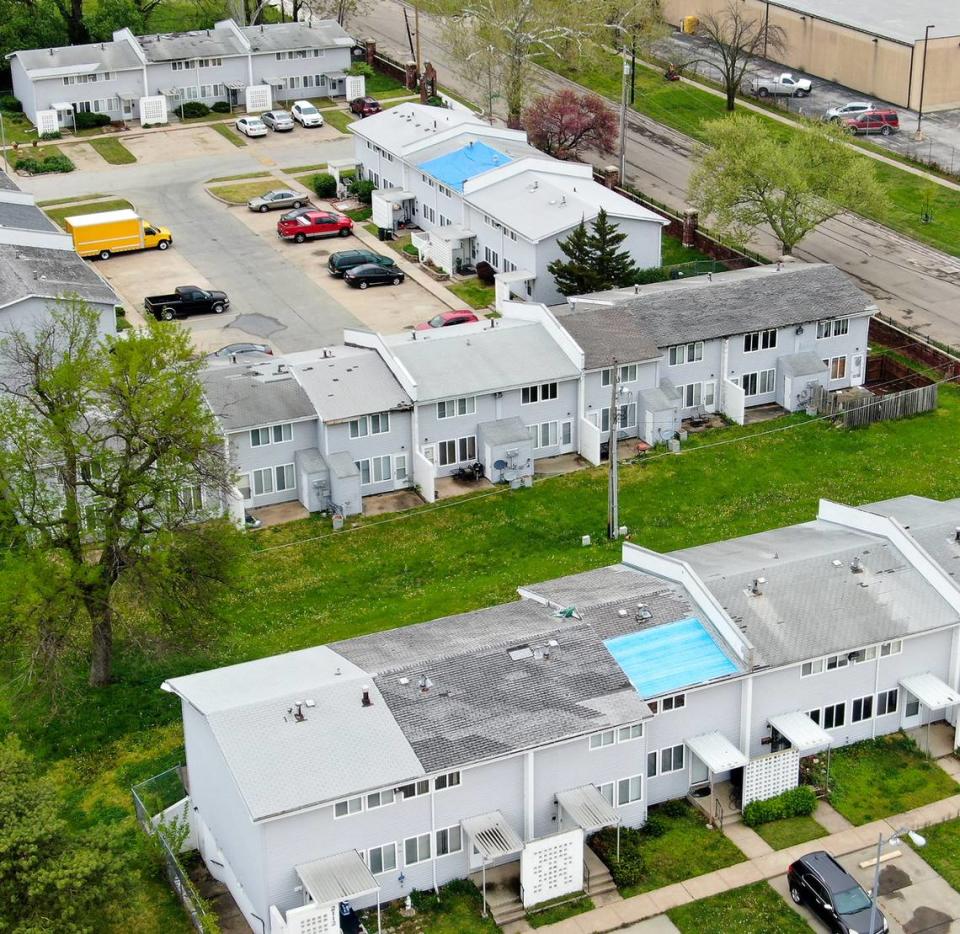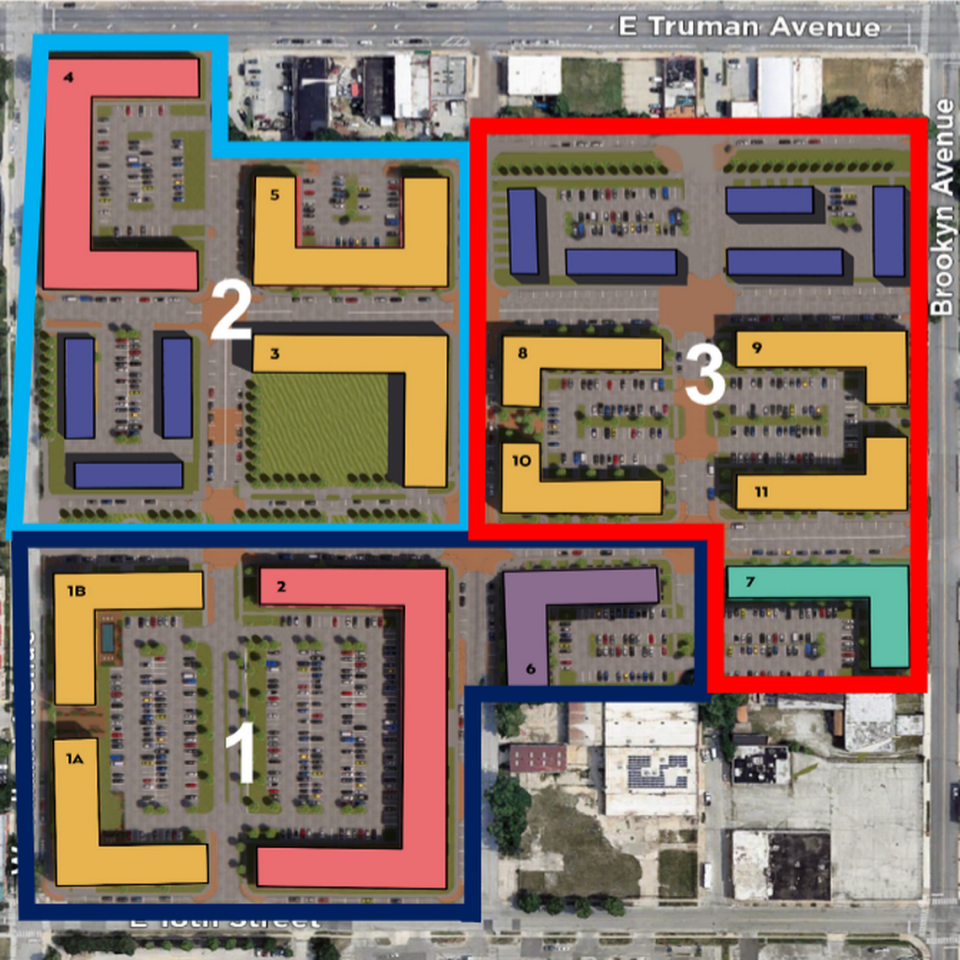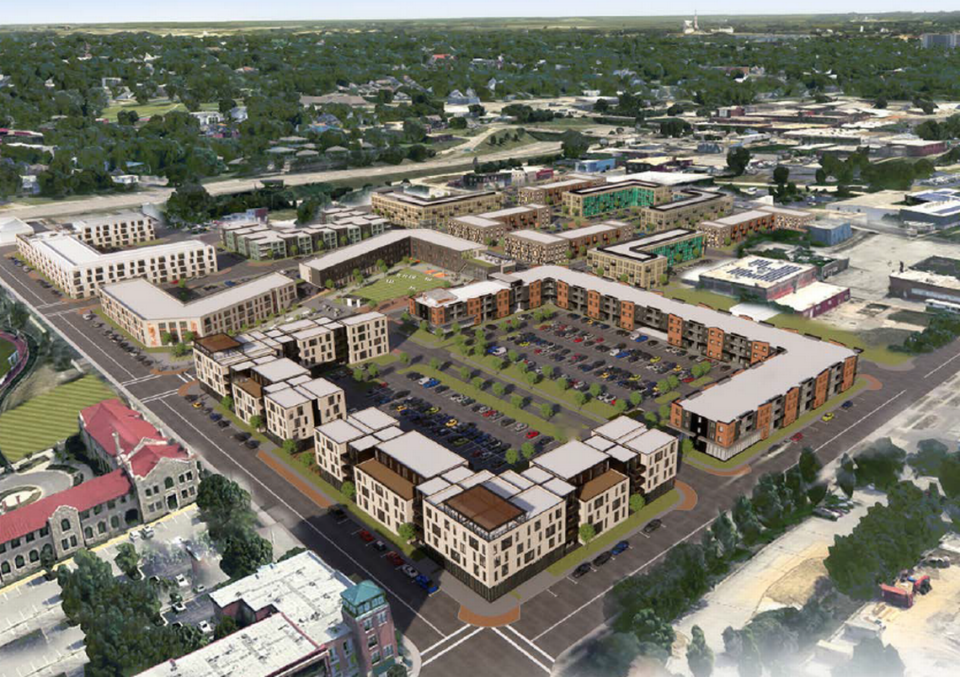1,000 new rentals will replace historic KC housing co-op. Here’s how much they’ll cost
Two real estate development companies have officially purchased Parade Park Homes, a historically Black former housing cooperative on Kansas City’s East Side.
The Kansas City-based 12th Street Heritage Development Corporation and the Indianapolis-based Flaherty & Collins Properties took joint ownership of the development March 11. The deal was announced in December, but few details about the redevelopment have been released until now.
A development planning document shared with The Star revealed plans to demolish the neighborhood’s 510 existing housing units and replace them with around 20 buildings containing 1,065 units, 470 of which will be designated for affordable housing.
The developers’ financial model projects rents ranging from around $885 to $1,164 per month in buildings designated for affordable housing. The 535 rental units in “market-rate” buildings are projected to rent for between $1,100 per month for a studio and $2,000 per month for a three-bedroom apartment.
Here’s what we know so far about developers’ plans for Parade Park Homes.
Why is Parade Park being redeveloped?
Parade Park Homes was one of the nation’s oldest Black-owned housing cooperatives, but has seen high vacancy rates and deteriorating living conditions in some units in recent years.
Monday’s sale marks the latest step in a years-long quest by community members, city leaders, federal housing authorities and private developers to chart a path forward for the historic neighborhood.
In late 2022, the U.S. Department of Housing and Urban Development (HUD) took control of the co-op over an outstanding $10 million debt and began the foreclosure process. The agency then sold the property to the city of Kansas City for $10 in an agreement that involved the city finding private developers to revitalize the neighborhood.
“Mayor Lucas’s Administration and City leadership began working closely with HUD to ensure the long-term ownership of Parade Park Homes would be one that paid respect to the neighborhood’s important history, prioritized current Parade Park residents and kept the neighborhood affordable, while doubling in size,” said Jazzlyn Johnson, a spokesperson for Mayor Quinton Lucas’ office.

But some community members, like third-generation Parade Park Homes resident Brian Hullaby, say that the new development plan was orchestrated without proper input from those who live there.
“The people in Parade Park, we kind of feel abandoned and left behind, like an afterthought,” Hullaby told The Star. “There’s nobody from the city at any of the meetings that the developers have with us. So maybe (city officials) did work behind the scenes, but they have not been here.”
Johnson said that while HUD has led the project’s outreach efforts to residents, city officials were present at two meetings the agency held with tenants in 2023 and two more in 2024.
“The City and the Developers held another tenant meeting on March 12, 2024—the day after the foreclosure sale—to ensure tenants fully understood and could make their voices heard about the future of Parade Park,” she added.
But Hullaby said that explanations of the city’s plans aren’t the same as true collaboration on shaping the neighborhood’s future.
“(Developers) have been telling us what’s going to happen and trying to convince us that it’s good for us, but we ourselves are not part of any of the plans,” he said. “We’re not at the negotiating table. We’re not talking to the architects and the developers about what we would prefer or what would benefit us.”
What will the new Parade Park Homes look like?
Parade Park Homes is a network of light gray townhouses bordered by 18th Street to the south, Truman Road to the north, Woodland Avenue to the west and Brooklyn Avenue to the east.
The neighborhood currently includes around 510 living units, of which less than 200 are occupied — but not for long. Planning documents show that developers intend to demolish the existing homes and construct 20 buildings containing a total of 1,065 living units.

Here’s what the colors on the map above mean:
Pink: affordable housing
Yellow: market-rate housing
Blue: buildings with units for purchase
Purple: senior affordable housing
Green: service-enriched affordable housing
Developers plan to carry out construction in three “phases,” marked with numbers above. The first stage will begin construction this spring, and the units will be ready by the spring of 2028, according to an estimated timeline in planning documents shared with the city. The second phase is scheduled to conclude in 2029, and the third in 2030.
Eight small buildings will contain 60 units for private sale to residents, while the other 12 buildings will be filled with hundreds of rental units — some rented at market rate, and others with lower rents designed to meet the federal government’s low-income housing standards.
Two of the buildings containing rental units will be set aside for specialized housing, including one for seniors and one for “service-enriched” housing, which provides residents access to social services on-site and through referrals.
While the aesthetics of Parade Park’s future buildings haven’t been finalized yet, renderings shared with The Star show large four-story buildings with retail space on the ground floor. The buildings are arranged in “blocks” enclosing parking lots and some outdoor green spaces.
What will rents cost in the new Parade Park Homes development?
We don’t know yet exactly what rents developers will charge in each new Parade Park Homes unit — but a financial planning document reviewed by The Star offers a glimpse at some projected rental costs
In its buildings containing designated “affordable” units, developers anticipate charging around $885 per month for a studio apartment, around $1,002 per month for a one-bedroom apartment and around $1,164 per month for a two or three bedroom apartment.
These rates aren’t set in stone. Developers generally need to set rents for low-income housing units at around 60% of the local area median income, or AMI, in order to receive tax credits from the federal government. When AMI rises, rents that the government considers affordable rise, too.
“When we go to open the property and deliver units, hopefully within 24 to 36 months, these (rents) are all going to look different,” said Julie Collier, Flaherty & Collins’ vice president of development. “Every year, these AMI maximums are published, and (they) typically go up with annual growth rates depending on what the economy is doing.”
Local housing advocates, like the citywide renters’ union KC Tenants, have said that rents based on 60% AMI are not truly affordable for those living in the city’s urban core.

Johnson with the mayor’s office noted that the city’s commitment to affordability included “requiring Parade Park to have units at all levels of affordability,” including those considered “deeply affordable” that are calculated based on 30% of local AMI.
Planning documents show that the new development intends to have nine such units in its service-enriched housing building and nine more in its senior housing building. They are projected to rent for around $468 per month for a studio and $486 per month for a one-bedroom apartment. These buildings are scheduled to become available to tenants in the spring of 2030.
Rents in the new development’s 535 market-rate units will vary depending on the housing market when they become available. Based on this year’s market trends, a studio is projected to rent for around $1,100 per month, a one-bedroom for $1,450, a two-bedroom for $1,800 and a three-bedroom for $2,000 in these buildings.
What will happen to current residents of Parade Park Homes?
Both the city and developers have touted their efforts to shield current Parade Park Homes residents from displacement using a three-pronged approach:
A “right to return” for current residents negotiated by the city
Tenant Protection Vouchers provided by HUD that eligible current residents can use for rental assistance anywhere they move
Relocation costs and a temporary rent freeze for current residents provided by developers
“Both the City and HUD are committed to ensuring that all current Parade Park residents can continue to live at Parade Park,” Johnson said. “On top of this, low-income current residents earners have a right to return to Parade Park at the same rent they paid before.”
But Alexis Williams of 12th Street Heritage, the other developer involved in the project, told The Star that this rent freeze is only good for two years. After that, rents could go up.
“All existing tenant rents will be protected until new units are provided,” the developers wrote in a recent notice to tenants that Williams shared with The Star. “Rents will not be increased until units are redeveloped.”
Hullaby says that he hopes to move back into Parade Park Homes once the new buildings are complete — but he worries that rising rents will eventually push his family out.
“If they put the stadium in the Crossroads, that’s a five-minute drive (away), and who knows what the rent will be,” he said. “Nobody here (now) will be able to afford to live here.”
Hullaby and his mother currently pay $805 per month for their three-bedroom apartment. A similar unit in one of the new development’s designated affordable buildings would cost $1,164 per month, which he says would pose a financial burden.
After generations of collective ownership, he worries that the new development plans will ultimately do away with the most important aspect of Parade Park Homes: the people who make up its close-knit community.
“When people talk about 18th & Vine, they talk about Gates, they talk about Arthur Bryant, they talk about the Negro Leagues Baseball Museum or the Negro Leagues in general. But they forget about the neighborhood that’s right in the middle of it, that made those things possible,” he said.
“I wish more people talked about it with reverence and respected the historical aspect of Parade Park. It’s not just some people who lived in a neighborhood for a long time. It was a lot more than that.”
Do you have more questions about housing and development in Kansas City? Ask the Service Journalism team at kcq@kcstar.com.

